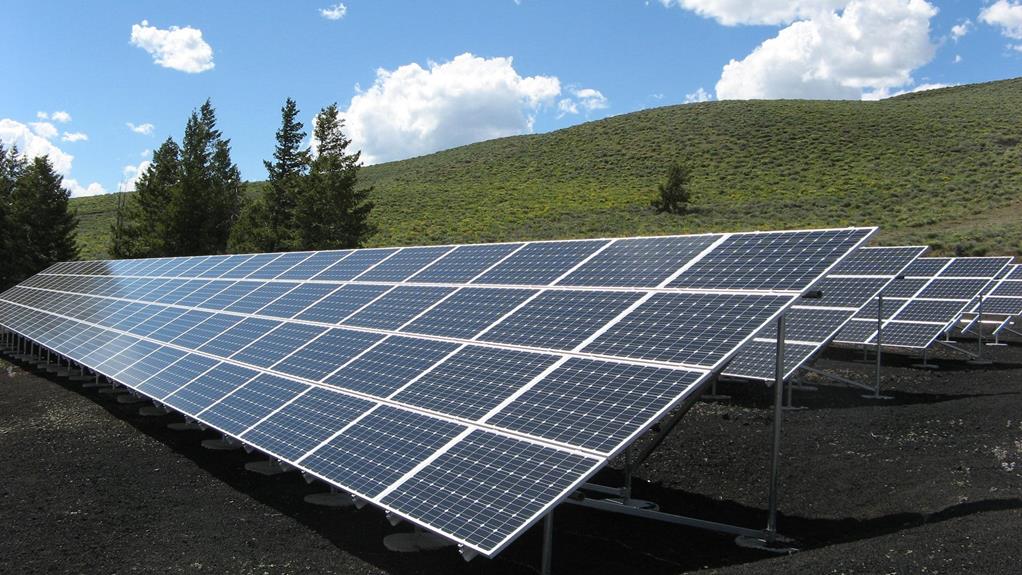15 Innovative Breakthroughs in Renewable Energy Technology
Are you ready to be amazed by the incredible breakthroughs in renewable energy technology? We have compiled a list of 15 innovative advancements that will leave you in awe. From floating solar panels to 3D printed solar energy trees, these advancements are revolutionizing the way we harness and utilize renewable energy.
Imagine solar windows that can generate electricity or vertical axis wind turbines that can be installed in urban areas. These breakthroughs not only provide cleaner and more sustainable energy solutions but also pave the way for a brighter and greener future.
Join us as we explore these remarkable inventions that are propelling us towards a world powered by renewable energy.
Floating Solar Panels
Floating solar panels, harnessing the power of the sun while conserving space and reducing water evaporation, are revolutionizing the renewable energy industry.
These innovative panels are mounted on platforms that float on bodies of water, such as reservoirs and lakes.
By utilizing the surface area of the water, floating solar panels are able to generate electricity without taking up valuable land space. This is particularly beneficial in densely populated areas where land is scarce.
Additionally, these panels have the added advantage of reducing water evaporation from reservoirs, which is a significant issue in many regions. The water-cooled panels also offer increased efficiency compared to traditional solar panels.
With their potential to significantly increase the adoption of solar energy, floating solar panels are paving the way for a more sustainable and environmentally friendly future.
Perovskite Solar Cells
Perovskite solar cells have emerged as a game-changing technology in the renewable energy sector. These solar cells utilize a mineral called perovskite, which offers high efficiency and low cost compared to traditional silicon solar cells.
One of the key advantages of perovskite solar cells is their simplicity and affordability in manufacturing. Unlike silicon-based solar cells, perovskite solar cells can be produced using simple and inexpensive processes.
Additionally, perovskite solar cells are lightweight and flexible, making them ideal for portable and wearable devices. Another remarkable feature of perovskite solar cells is their ability to be made semi-transparent, making them suitable for integration into windows and building materials.
With their high efficiency, low cost, and versatility, perovskite solar cells hold great promise for revolutionizing the renewable energy industry.
Solar Windows
Integrating photovoltaic cells into the glass, solar windows offer a practical and visually appealing solution for generating electricity from sunlight while still allowing it to pass through. These innovative solar technologies provide an easy and effective way for homeowners to generate their own energy.
With solar windows, every window in a house can be designed to supply electricity, making them a practical innovation for achieving energy self-sufficiency. By harnessing the power of the sun, solar windows can generate up to 30% of a building’s power needs, reducing the reliance on traditional energy sources. This not only helps to lower electricity bills but also contributes to sustainable building practices.
Solar windows are a visually appealing and functional solution for homeowners who want to embrace renewable energy and reduce their carbon footprint.
Vertical Axis Wind Turbines
Continuing our exploration of innovative renewable energy technologies, let’s now turn our attention to the game-changing Vertical Axis Wind Turbines (VAWTs). These wind turbines offer a range of benefits and advancements in the field of renewable energy.
Here are four key points to consider:
- Versatility: VAWTs are designed to capture wind energy from any direction, making them suitable for various settings. Unlike traditional horizontal axis wind turbines, VAWTs aren’t dependent on wind direction, making them ideal for urban areas and locations with unpredictable wind patterns.
- Urban Solutions: Due to their unique design with vertically positioned blades, VAWTs can be installed in residential homes and commercial buildings. This not only provides a quieter energy solution but also maximizes energy generation in urban environments where space is limited.
- Room for Innovation: VAWTs offer room for further innovation and improvement. Researchers and engineers are constantly exploring new designs and materials to enhance their performance and efficiency. This continuous development contributes to the advancement of wind energy technology as a whole.
- Advancement in Wind Energy: The development and use of VAWTs represent a significant breakthrough in the field of wind energy generation. By harnessing the power of wind in a more versatile and efficient manner, VAWTs contribute to the transition towards a cleaner and more sustainable energy future.
With their versatility, urban suitability, potential for innovation, and contribution to the advancement of wind energy, Vertical Axis Wind Turbines are certainly an exciting and promising technology in the realm of renewable energy.
Offshore Wind Turbines
When it comes to offshore wind turbines, there are several key points to consider.
Firstly, these turbines have the potential to significantly increase energy production compared to their onshore counterparts, thanks to the stronger and more consistent winds found at sea.
Secondly, offshore wind turbines offer important environmental benefits, such as minimizing visual and noise impacts on local communities.
Lastly, advancements in turbine design have made offshore wind farms more efficient and cost-effective, further driving their adoption as a viable renewable energy solution.
Increased Energy Production
Offshore wind turbines offer a substantial increase in energy production potential. Here is why they’re a game-changer in renewable energy:
- Higher wind speeds: Offshore turbines are strategically placed in bodies of water where winds are stronger and more consistent. This allows them to capture more wind energy and generate a higher amount of electricity compared to onshore turbines.
- Greater capacity: Offshore wind farms have the ability to house a large number of turbines, creating a significant capacity for energy production. These wind farms can generate enough electricity to power entire cities, contributing to meeting the increasing energy demands of our society.
- Reduced visual and noise impact: Unlike onshore turbines, which can be visually and audibly intrusive to local communities, offshore turbines minimize these impacts. This makes them more socially acceptable and allows for the expansion of renewable energy without compromising the aesthetics of coastal areas.
- Renewable energy source: Offshore wind power is a clean and renewable source of energy. By harnessing the power of wind, we can reduce our dependence on fossil fuels and move towards a sustainable and environmentally-friendly future.
Environmental Benefits and Impact
An article about the environmental benefits and impact of offshore wind turbines is now discussed, highlighting their role in reducing carbon emissions and providing clean, renewable energy.
Offshore wind turbines offer a sustainable solution for power generation, contributing to the production of clean energy and renewable electricity. By harnessing the power of wind from bodies of water, these turbines minimize environmental impact while maximizing energy production.
Located in areas with consistent winds, offshore wind turbines take advantage of stronger winds near the shore, allowing for a significant amount of energy generation. Moreover, their placement in bodies of water minimizes visual and noise impacts on local communities, making them an environmentally friendly option.
Advancements in Turbine Design
To delve into the advancements in turbine design for offshore wind turbines, let’s explore the innovative breakthroughs that have revolutionized the renewable energy technology landscape.
Here are four noteworthy advancements in turbine design:
- Increased blade length: Longer blades capture more wind energy, resulting in higher electricity generation. Advances in materials and manufacturing techniques have made it possible to produce blades of exceptional length without compromising structural integrity.
- Floating turbine technology: Traditional offshore turbines are fixed to the sea floor, but floating turbines are designed to operate in deeper waters, where wind speeds are often higher. These innovative designs employ advanced mooring systems to ensure stability and enable the deployment of wind farms in previously inaccessible locations.
- Horizontal axis turbines with yaw control: Yaw control allows the turbine to align itself with the wind direction, optimizing energy capture. Combined with horizontal axis turbines, which are more efficient than vertical axis turbines, this design improvement significantly enhances overall performance.
- Integrated sensor technology: Sensors embedded within the turbine monitor various parameters such as wind speed, direction, and structural integrity. This real-time data enables operators to optimize turbine performance, detect maintenance needs, and ensure safe and efficient operation.
These advancements in turbine design for offshore wind turbines have propelled the renewable energy industry forward, enhancing the efficiency, reliability, and environmental impact of wind power generation.
Airborne Wind Energy
In our exploration of innovative breakthroughs in renewable energy technology, we now delve into the fascinating realm of airborne wind energy.
Airborne wind energy, also known as AWE, is a cutting-edge approach to generating electricity using wind turbines mounted on flying devices. This technology takes advantage of stronger and more consistent winds at higher altitudes, where traditional wind turbines aren’t feasible.
By harnessing the potential of these stronger winds, AWE offers a promising solution for decentralized energy generation. It’s particularly suitable for remote or off-grid locations, providing a sustainable energy source for areas with limited access to traditional energy sources.
With its ability to tap into the power of high-altitude winds, airborne wind energy represents an exciting advancement in renewable energy technology.
Tidal Energy
Tidal energy offers numerous benefits as a renewable energy source. It provides a clean and predictable source of energy by harnessing the power of ocean tides.
Additionally, tidal energy systems have the potential to generate large amounts of electricity, making them a promising future solution for sustainable energy production.
Tidal Energy Benefits
One of the most significant benefits of harnessing tidal energy is the consistent and reliable source of renewable power it provides.
Here are four key benefits of tidal energy:
- Clean and sustainable: Tidal energy is a clean source of power that produces no greenhouse gas emissions or air pollution. By harnessing the power of ocean tides, we can reduce our reliance on fossil fuels and contribute to a cleaner and healthier environment.
- Predictable and consistent: Unlike other renewable energy sources like solar and wind, tidal energy is highly predictable and consistent. The tides follow a predictable pattern, making it easier to forecast the amount of energy that can be generated. This reliability makes tidal energy a dependable source of power.
- High energy density: Tidal energy has a high energy density, meaning that a small area of the ocean can produce a significant amount of energy. This makes it a highly efficient form of renewable energy, capable of generating large amounts of power even in relatively small installations.
- Long lifespan: Tidal energy systems have a long lifespan, typically lasting 20-30 years or more. This longevity ensures a sustainable and reliable source of power for many years to come, contributing to the stability of our energy infrastructure.
Future of Tidal Energy?
As we explore the future of tidal energy, it’s clear that innovative breakthroughs in renewable energy technology hold immense potential for further advancements in harnessing this consistent and reliable source of power.
Tidal energy has already proven itself as a viable option for generating electricity, but there are still areas for improvement and growth.
One key aspect of the future of tidal energy lies in the development of more efficient and cost-effective turbines. By increasing turbine efficiency, we can maximize power generation and reduce operational costs.
Additionally, advancements in materials and design can help increase the lifespan of tidal energy systems, making them more economically viable in the long run.
Furthermore, the integration of tidal energy into existing energy grids and the development of energy storage solutions will be crucial for ensuring a stable and reliable power supply.
The future of tidal energy looks promising, and with continued research and development, it has the potential to play a significant role in the future renewable energy mix.
Wave Energy
Utilizing the kinetic energy of ocean waves, we’ve made significant strides in harnessing wave energy through innovative breakthroughs in renewable energy technology. Here are four key developments that have propelled wave energy towards becoming a sustainable energy source:
- Advanced Wave Energy Converters (WECs): Engineers have designed sophisticated WECs that effectively capture and convert the energy from ocean waves into electricity. These devices are equipped with efficient mechanisms to maximize power generation.
- Wave Resource Assessment: Accurate assessment of wave resources is crucial for successful wave energy projects. Researchers have developed advanced models and technologies to analyze wave characteristics, allowing for precise identification of suitable locations for wave energy farms.
- Grid Integration Solutions: To integrate wave energy into existing power grids, engineers have developed innovative solutions. These include smart grid technologies, energy storage systems, and power management strategies, ensuring a smooth and efficient integration of wave energy into the existing energy infrastructure.
- Research and Development: Continuous research and development efforts have led to improvements in wave energy technologies. Scientists are exploring new materials, optimizing designs, and refining operational strategies to enhance the efficiency and reliability of wave energy systems.
These advancements highlight the immense potential of wave energy as a sustainable and reliable source of power. By harnessing the power of the ocean waves, we’re moving closer to a future powered by clean and renewable energy.
Solar Powered Trains
Solar powered trains offer a highly efficient and sustainable mode of transportation. By harnessing the power of the sun, these trains can operate without the need for constant recharging, reducing their reliance on traditional energy sources. This not only reduces carbon emissions but also has the potential to export excess energy back to the grid, further contributing to the renewable energy landscape.
Additionally, advancements in solar technology have made solar powered trains more feasible and cost-effective, paving the way for a greener future in the transportation sector.
Efficiency of Solar Trains
We have witnessed remarkable advancements in the efficiency of solar trains. As we delve into the world of solar power and its impact on railway transportation, let’s explore the efficiency of solar trains. Here are four key points to consider:
- Increased energy generation:
- Solar trains are equipped with advanced photovoltaic panels that capture sunlight and convert it into electricity.
- These panels have become more efficient over time, allowing trains to generate more energy from the same amount of sunlight.
- Long-lasting power supply:
- Solar powered trains can operate all day without the need for recharging.
- The energy generated by the solar panels is stored in onboard batteries, ensuring a continuous power supply even in low sunlight conditions.
- Grid contribution:
- Solar trains not only power themselves but also have the potential to export excess energy back to the grid.
- This contributes to the overall renewable energy supply, reducing dependence on non-renewable sources.
- By harnessing solar power, trains become a cleaner and more sustainable mode of transportation.
- Solar energy reduces greenhouse gas emissions and helps combat climate change, making solar trains a promising solution for a greener future.
The efficiency of solar trains is a testament to the advancements in renewable energy technology. As we continue to explore the potential of solar power, the future of energy-efficient transportation looks bright.
Environmental Impact Reduction
Through the integration of renewable energy technology, we can actively contribute to the reduction of environmental impact caused by traditional train transportation. Solar powered trains offer an innovative solution in the energy transition towards sustainable transportation. By harnessing the power of the sun, these trains can operate without the need for external sources of energy, reducing carbon dioxide emissions.
The energy generated by solar powered trains can also be exported back to the grid, further enhancing the environmental benefits. Solar power is the third-largest renewable electricity technology and plays a crucial role in reducing our carbon footprint. According to the International Energy Agency, renewable energy accounts for 29% of the world’s electricity generation.
Through the widespread adoption of solar powered trains, we can significantly contribute to the reduction of carbon dioxide emissions and create a cleaner, more sustainable future.
Advancements in Solar Technology
By harnessing the power of the sun, we can propel the discussion of renewable energy technology forward with innovative advancements in solar technology, such as the development of solar powered trains. Here are four key advancements in solar technology that have made solar powered trains a possibility:
- Solar panels on trains: Solar panels, also known as solar photovoltaic (PV) systems, are installed on the roofs of trains. These panels capture sunlight and convert it into electricity, which can be used to power the train’s motors.
- Energy storage systems: To ensure uninterrupted power supply, solar powered trains are equipped with energy storage systems. These systems store excess energy generated by the solar panels during the day and use it during periods of low sunlight or at night.
- Grid integration: Solar powered trains aren’t only self-sufficient but can also export excess energy back to the grid. This means that the energy generated by these trains can be used to power other systems or buildings, further reducing dependence on fossil fuels.
- Continuous operation: Unlike traditional trains that require frequent refueling or recharging, solar powered trains can run all day without needing to recharge. This makes them more efficient and reduces operational costs.
With these advancements, solar powered trains are paving the way for a cleaner and more sustainable future in the transportation sector.
Food Waste Solar Panels
Exploring the potential of utilizing discarded food to create solar panels is an exciting development in renewable energy technology. This new technology, known as food waste solar panels, offers a sustainable solution to both the food waste problem and the need for clean energy sources.
These panels are made from luminous particles derived from fruits and vegetables that would otherwise be discarded. The idea was conceived by an engineering student and received recognition through the prestigious James Dyson Award.
By repurposing food waste into solar panels, we can reduce waste and promote sustainability in a unique and innovative way. This breakthrough showcases the constant advancements in the energy sector and highlights the immense potential of renewable energy in different industries.
With food waste solar panels, we can create a more sustainable future while addressing the pressing issues of waste management and energy production.
Bladeless Wind Energy
Bladeless wind energy technology offers several advantages, including noise reduction and increased efficiency in wind energy generation.
With the absence of rotating blades, these bladeless wind turbines produce less noise compared to traditional wind turbines, making them suitable for urban and residential areas.
Additionally, the unique design of bladeless wind turbines allows for improved efficiency in capturing wind energy, resulting in higher energy output and better utilization of available wind resources.
These advancements in bladeless wind energy technology contribute to the ongoing efforts to develop more efficient and environmentally friendly renewable energy solutions.
Noise Reduction in Wind
One key aspect of noise reduction in wind energy is the implementation of innovative technologies that minimize sound emissions. When it comes to wind farms, noise reduction is a crucial consideration to ensure minimal disturbance to surrounding communities.
Here are four innovative approaches to noise reduction in wind:
- Aerodynamic design optimization: By improving the shape and structure of wind turbine blades, researchers can reduce noise caused by aerodynamic forces, resulting in quieter operation.
- Active noise control systems: These systems use advanced algorithms and sensors to detect and cancel out noise generated by wind turbines, effectively reducing the overall sound emissions.
- Sound-absorbing materials: Incorporating sound-absorbing materials into wind turbine components can help to dampen noise and minimize its propagation.
- Distance and layout planning: Proper planning and positioning of wind turbines in relation to residential areas can significantly reduce the impact of noise on nearby communities.
Increased Efficiency in Wind
How can we further increase the efficiency of wind energy without relying on traditional blade-based turbines?
One innovative solution to this problem is the development of bladeless wind turbines. These turbines, such as the design created by Vortex Bladeless, utilize an elastic rod that sways within the wind’s speed range to generate energy.
This unique approach to harnessing wind power offers several advantages. Firstly, bladeless wind turbines are suitable for urban or residential areas with limited space, making them a viable option for a wider range of locations. Additionally, the absence of rotating blades in these turbines reduces the risk of bird and bat collisions, addressing a common concern in the renewable energy sector.
The development of bladeless wind turbines represents a significant advancement in renewable energy technologies and contributes to the ongoing improvements in wind energy efficiency.
Lithium-Glass Batteries
Lithium-glass batteries offer a promising solution for renewable energy storage. These innovative technologies have the potential to revolutionize the way we store and utilize electricity.
Here are four key reasons why lithium-glass batteries are a game-changer in the field of energy storage:
- Higher energy density: Lithium-glass batteries have a higher energy density compared to conventional batteries. This means they can store more energy in a smaller and lighter package, making them ideal for portable applications and electric vehicles.
- Longer lifespan: These batteries have a longer lifespan, allowing them to be used for a longer period of time before needing to be replaced. This not only reduces waste but also provides a more cost-effective solution in the long run.
- Lower temperature operation: Lithium-glass batteries work at lower temperatures, which reduces the risk of overheating and improves safety. This makes them suitable for a wide range of applications, including renewable energy storage.
- Faster charging: Lithium-glass batteries charge more quickly compared to conventional batteries. This means shorter charging times and increased efficiency, enabling a faster turnaround for renewable energy systems.
With their increased capacity and improved performance, lithium-glass batteries are poised to play a critical role in the transition to a renewable energy future.
Rechargeable Tires
The development of rechargeable tires signifies a significant advancement in renewable energy technology. Goodyear, a renowned tire manufacturer, is spearheading this innovation by creating tires for electric vehicles that aren’t only rechargeable but also made from a biological substance.
These concept tires are strengthened with fibers modeled after spider silk, making them exceptionally durable. The key benefit of rechargeable tires is their ability to adapt and change to meet individual mobility needs, reducing the time spent on changing tires and improving overall efficiency.
Moreover, the use of biodegradable materials in these tires promotes sustainability, aligning with the trend of innovative breakthroughs in renewable energy technology. Goodyear’s approach with rechargeable tires showcases the potential for integrating sustainable materials in the transportation sector to further the renewable energy transition, making it a significant step forward in the automotive industry.
3D Printed Solar Energy Trees
We can continue exploring the realm of renewable energy technology with the introduction of 3D printed solar energy trees. These artificial trees, created by researchers at VTT Technical Research Centre of Finland, have the ability to collect solar, kinetic, and heat energy.
Here are four key features of these innovative trees:
- Energy Conversion: The 3D printed solar energy trees can convert the collected energy into electricity, which can then be used to power small appliances or devices.
- Versatile Placement: These energy-harvesting trees can be placed in gardens and natural settings, blending seamlessly with the environment while offering sustainable energy solutions.
- Environmental Benefit: By planting energy-harvesting trees instead of cutting down natural trees for energy, we can promote sustainability and preserve our natural ecosystems.
- Prototype Potential: The prototype of 3D printed solar energy trees showcases the potential for innovative solutions in the renewable energy sector, paving the way for further advancements in harnessing solar energy through 3D printing technology.
Waste Power Planes
Regularly, we utilize waste-derived fuels to power aircraft, contributing to the circular economy and reducing carbon emissions from air travel.
However, a new development in renewable energy technology is set to revolutionize the aviation industry even further. Waste power planes, powered solely by waste-derived fuels, offer a sustainable solution to the environmental impact of air travel. By harnessing the power of waste as a renewable energy source, these planes have the potential to significantly reduce carbon emissions.
This innovative breakthrough showcases the continuous progress in renewable energy research and highlights the potential for waste-to-energy solutions in various industries. With the power of waste, these planes represent a new era in aviation, where sustainability and efficiency go hand in hand.
The future of air travel is powered by waste, paving the way for a cleaner and greener world.
Conclusion
In conclusion, these innovative breakthroughs in renewable energy technology are paving the way for a more sustainable future.
From floating solar panels to lithium-glass batteries, these advancements are revolutionizing the way we harness and store clean energy.
They hold the key to unlocking a more reliable and resilient renewable energy grid.
As the saying goes, ‘The future is bright,’ and with these advancements, we can confidently say that the future of renewable energy is indeed shining brightly.




